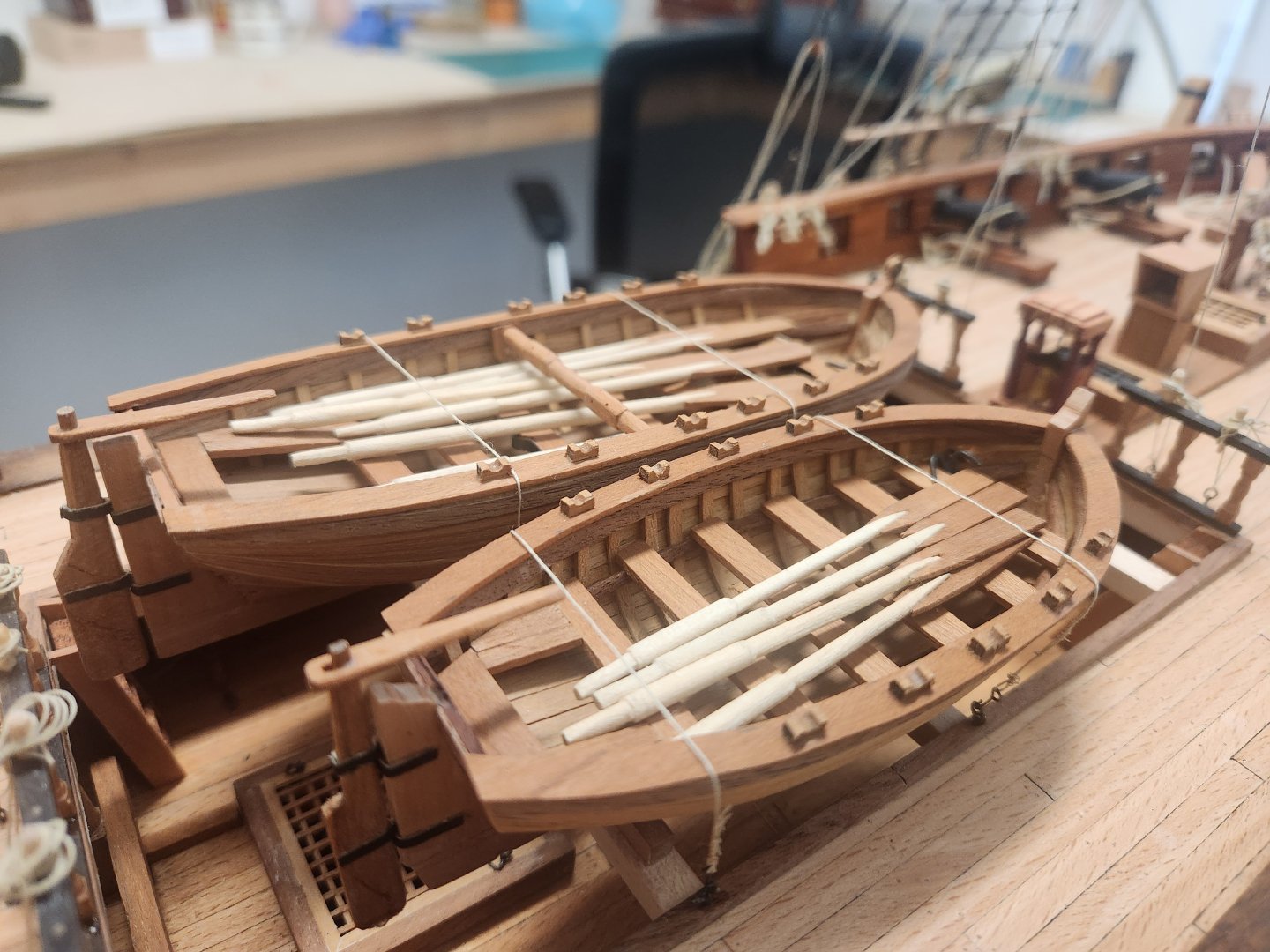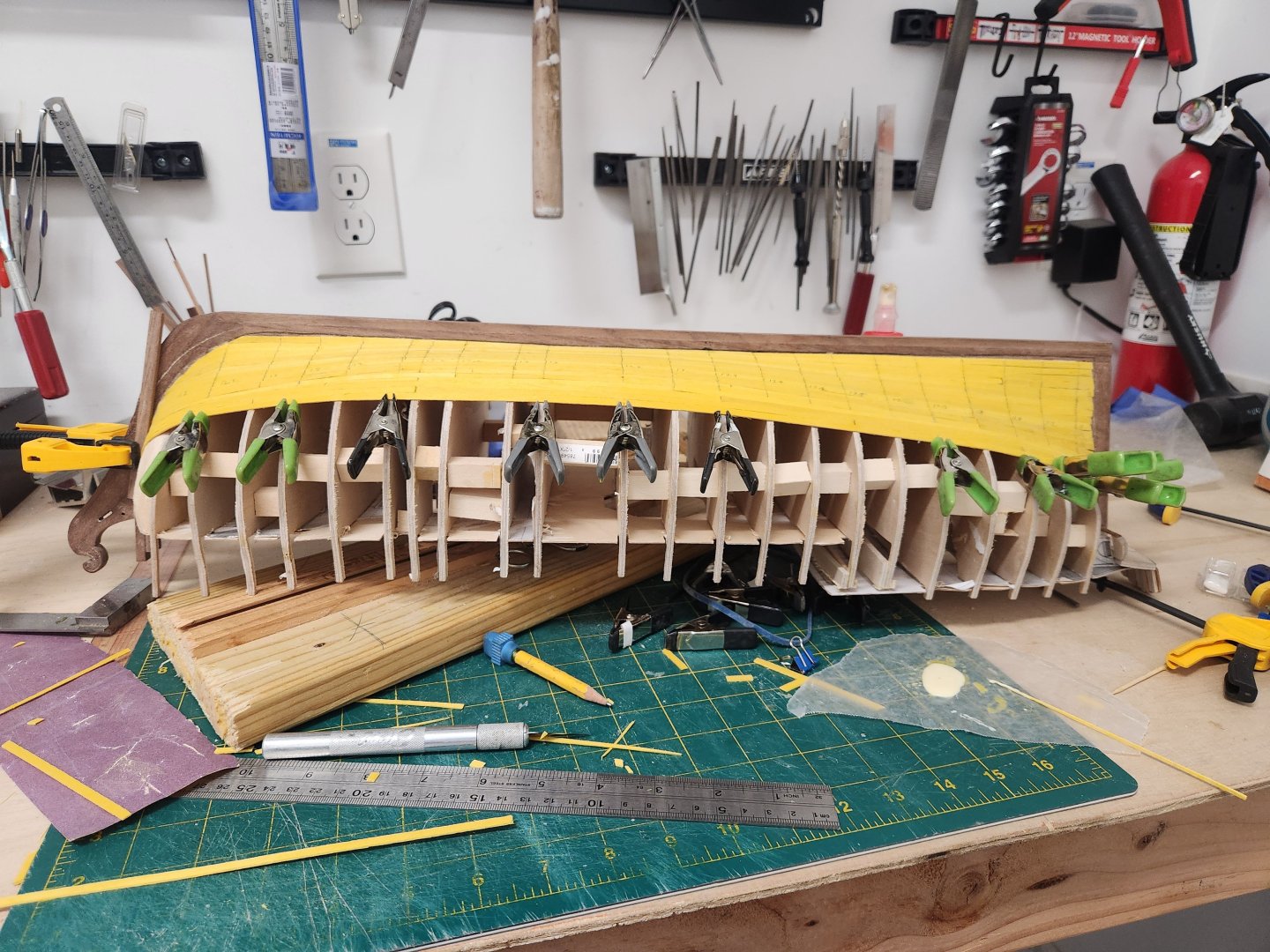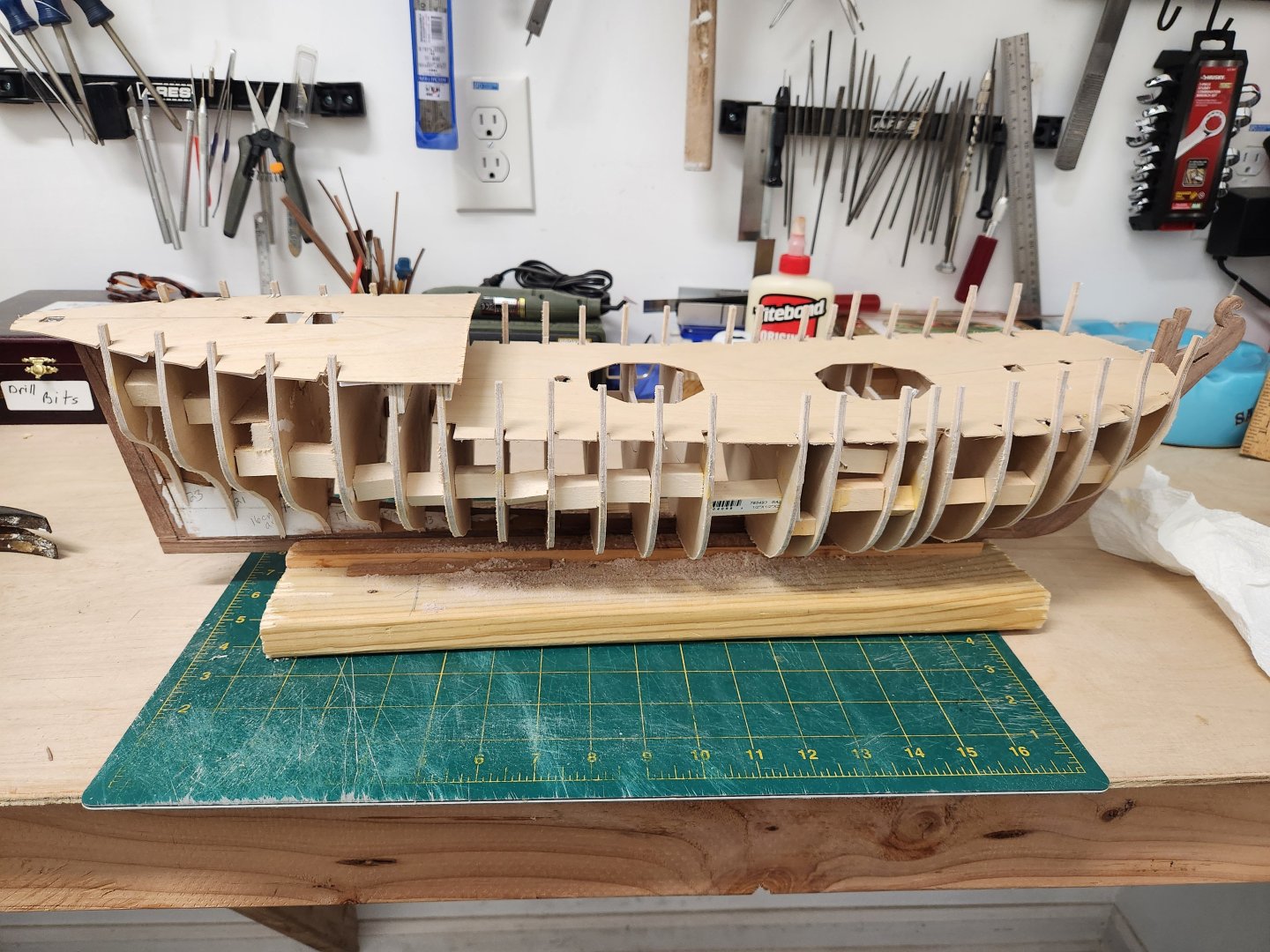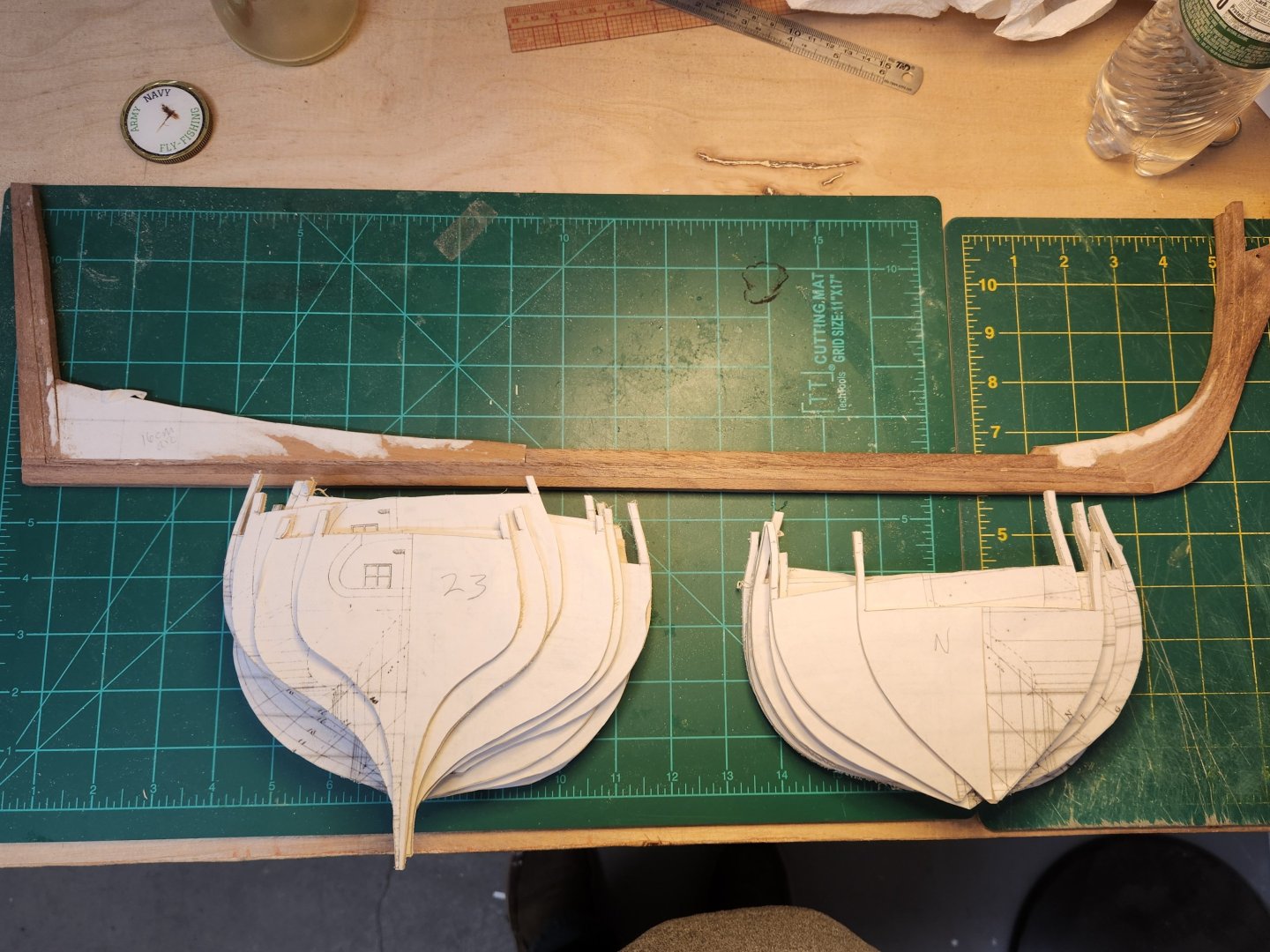
barkeater
NRG Member-
Posts
409 -
Joined
-
Last visited
Content Type
Profiles
Forums
Gallery
Events
Everything posted by barkeater
-
Have fun. Rich
-
Carcass 1758 by barkeater - scale 1:48
barkeater replied to barkeater's topic in - Build logs for subjects built 1751 - 1800
The second planking is coming along. For scale 1/48, maximal length of planks is 5 inches. This would be 20 feet. My trenails ae .6 mm or #72 drill bit which would give me to scale just over an inch. Rich -
question about waxing thread
barkeater replied to ford34tom@comcast.net's topic in Masting, rigging and sails
Wax before using and use white glue to secure knots or stiffen after. Depending on your thread you may or may not need to wax, Cheaper thread tends to be fuzzy in my experience while well-made thread does not. Rich -
Carcass 1758 by barkeater - scale 1:48
barkeater replied to barkeater's topic in - Build logs for subjects built 1751 - 1800
The model is now ready for the second planking. Any rough or low spots have been filled and everything sanded smooth. I have penciled lines where the bulkheads are. These will be where the butts of planks are placed. I use trenails throughout. I also measure along each line to figure out my overall taper. I'll do 5 to 10 planks and then remeasure and adjust rather than breaking the hull surface into smaller divisions. This allows me to deal with any problem in tapering before it is apparent and so do a milder taper over a longer stretch. Rich -
You can fix it in either of two ways. First option, take an EXTRA piece of wood strip for planking and either run it up the bulkhead and glue with pva or cut several small pieces and place these across the bulkhead so your planking will have contact wood continuously to glue to. You probably will have to sand down or file it down at least the end to taper depending on your situation. If you run it up long ways, then you probably are going to have to clamp or heat bend in your case. Be careful you don't snap off the bulkhead as they can be somewhat fragile. If you ever do break a bulkhead, you can just sister brace them with a piece of wood. Finally, it looks like you are going to have to add some wood to the bulkhead below the deck as well from your picture. Second option, you could shave the extra wood from your false deck, so it doesn't stick out. Just lay a plank across the bulkheads from for to aft and slowly and carefully trim away the excess wood so that the plank you are using as a reference can slide up and down over the deck. Rich
-
Carcass 1758 by barkeater - scale 1:48
barkeater replied to barkeater's topic in - Build logs for subjects built 1751 - 1800
I realized that I had not put up a good picture of the stern plans. On the pictures of the model, I have to curve in the upper bulwarks which I forgot to mention. Also, the reason I did not steam bend is that the stern has two windows which along their bottom just have a sill. I felt that my chance of getting a smooth curve throughout the plywood would be significantly decreased with the window cutouts. Rich -
Carcass 1758 by barkeater - scale 1:48
barkeater replied to barkeater's topic in - Build logs for subjects built 1751 - 1800
Here are a couple pictures of the stern. The stern in this ship is unusual as I'm sure you noticed. Before I start, please excuse the appearance. I have a lot more work to do sanding and smoothing. I had two options in forming the stere. Either I steam bent a piece of plywood which I've done before or file the plywood down to give the proper angle, so I cut curve the stern forward. I decided to go with the latter. This meant that instead of running the first plank to the outer edge of the plywood I needed to tuck it in behind which is what I did. I've indicated on the side view how I will run the trim forward to give the appearance of a curved stern. The trim will be applied over the first planking, so I have a little leeway in fitting it flush and then I'll bring the second hull planking up to it covering any small gap. For the stern itself I'm thinking vertical planks in purple heart and yellow heart which should give a nice decorative appearance. For the upper stern counter, I have not figured out my plank pattern or color scheme yet. Rich -
Carcass 1758 by barkeater - scale 1:48
barkeater replied to barkeater's topic in - Build logs for subjects built 1751 - 1800
The gun ports have now been framed and the first planking completed. I have penciled in the gun ports on the aft portion of the ship. These will be depicted as closed on the finished model, so I did not need to frame them. I have left holes (1 each side) where the cabin windows will go. The window frames will be applied after the second planking. Also, the gun ports are slightly larger than will be present on the finished model as these will be lined in this case with red heart. Next up, a lot of sanding and a bit of filler. Rich -
deck planking options
barkeater replied to manning16's topic in Building, Framing, Planking and plating a ships hull and deck
-
There was some variation in length for a given ball weight. Larger canons were longer and would be placed on lower decks for stability. I have never heard of shorter gun barrels for small vessels in the same shot weight. Rather the shot weight determined the length with some manufacturing variation. Smaller vessels naturally had smaller weight canons and larger vessels would have multiple canon sizes with larger on the lower decks Rich ty.
-
Carcass 1758 by barkeater - scale 1:48
barkeater replied to barkeater's topic in - Build logs for subjects built 1751 - 1800
First planking is done up to the deck which I marked with a black dyed plank for visual reference when I do the second planking. Next job is to frame out the gun ports and windows before I finish up planking to the top of the gunwales. Rich -
Planking disaster
barkeater replied to sgrez's topic in Building, Framing, Planking and plating a ships hull and deck
ok, my two cents. I use wood glue (pva) when joining wood or wood products (paper). If I need to glue wood to metal or plastic, I use cyanoacrylate (ca). My planking I do with pva. I heat bend my planks before gluing and even if I have to clamp with my fingers, a slow count to 100 usually gives enough time to set the glue. Ca is messy and if you get it on a surface it will stain. Even if you paint you can see the stain as it is plastic and fills in the wood grain. You also can't easily sand it out either. Yes, you can remove with acetone but with excess pva I just wipe with a wet paper towel. It also sands nice with no staining. My main use for ca is pinning deck furniture where I place a pin internally and glue it to a hole drilled in the deck. -
Beautiful work. Rich
-
Planking disaster
barkeater replied to sgrez's topic in Building, Framing, Planking and plating a ships hull and deck
You're ok, just taper the remaining planks. The first planking in a double planking is really just a base to apply the second planking to. I would get rid of the nails as has previously been noted. You can't sand them. Use some wood filler and sand nice and smooth to receive the second planking. Have fun. Rich -
Here's a tip I don't think anybody has mentioned. The tapered surface of the plank should always go against an already installed plank. The planks free edge is therefore straight and any gap that needs to be corrected is against an installed plank and readily apparent before glueing. Also, if you use steam bending, let the finished plank sit overnight in place before gluing. Wet wood swells. Degree is minimal but you want to get the tightest fit you can. Rich here's a tip I don't
-
Carcass 1758 by barkeater - scale 1:48
barkeater replied to barkeater's topic in - Build logs for subjects built 1751 - 1800
I've been working on the first planking. I thought I ordered natural strips but I either hit the wrong button or they sent me the wrong color. Doesn't matter as this will all be covered up. It does look though like it would glow in the dark at this point, however. Not quite sure yet how the planking is going to wind up at the stern. I may be able to continue or put in an additional piece. oh well, that's part of the fun figuring it out. Rich -
Welcome aboard. Have fun. Rich
-
Carcass 1758 by barkeater - scale 1:48
barkeater replied to barkeater's topic in - Build logs for subjects built 1751 - 1800
The bulkheads have been installed as well as the sub decks for both the main deck and quarterdecks. There is a foredeck, but this is open to the main deck along its aft portion. I will not do a subdeck but rather a single plank on beams. I found two slightly different sets of plans from the NMR. One has two masts while the other has three and the quarterdecks are different lengths. I went with the 3 masts as this is how she is depicted by John Cleverly the Younger on her Nordic expedition with the Racehorse. Next job is fairing. -
Ronald, Think of the hull as one big batten instead of dividing it up into multiple smaller battens. I plank from the keel up. Now, I know at the top planking at the bulwarks, if I've cut out my bulkheads correctly, I will have a true or correct run of the planks. The needed taper of planks in between the keel and the top plank can therefore be calculated. Using the entire hull gives me the advantage that I can correct any tapers that need to be made gradually rather than having to make larger or greater corrections in a briefer run. This is especially useful along the stern where you can have an area where you need to increase your widths and have another area where you need to taper. I don't mean to disparage other methods, but this method works best for me. Rich
-
I measure the run of each bulkhead once the first planking is done and pencil them in on the hull at their appropriate bulkhead. I then do a run of 10 planks and remeasure allowing me to adjust plank widths ahead of time repeating every 10 planks. This prevents me from running into trouble and having to use a drop a plank or stealer. I do trenails and plank lengths in scale. To help facilitate this I may add false bulkheads where needed to allow me to stay below 20 feet to a plank in scale. Rich
-
I Have an Itch to Scratch
barkeater replied to SaltyScot's topic in Modeling tools and Workshop Equipment
Mark, As Jim said, you can purchase milled lumber which is actually easier than milling your own for the planking or deck. The exception would be if you want to include exotic woods such as yellow heart or ebony where milled pieces can't be obtained. The one machine I would find tough to replace by other means is a scroll saw for cutting odd shapes. I have a table saw and a thickness planner. I find the thickness planner very useful for making sure the stock I personally milled is uniform. I also have a mini lathe. I don't have a drill press. Welcome to scratch building. It's a lot of fun and it opens up a lot more opportunities as to what you can build. Rich -
What scale? I've used the liquid glass product before, and it works well as long as your openings are not too big. I work in 1/48 scale. If your window is divided into multiple panes, it makes it easier. I've used thread to make panes in the frame. Also, the liquid glass is semi opaque. Lastly, I have bought mica chips which I'm going to try on my current build but have no experience with yet. Rich
-
Carcass 1758 by barkeater - scale 1:48
barkeater replied to barkeater's topic in - Build logs for subjects built 1751 - 1800
Rabbet line is done, and bulkheads have been cut out. I will trim them to fit the keel assembly as I go. Also next up framing out the stern assembly. Rich -
Mohogany plank bending
barkeater replied to Bontie's topic in Building, Framing, Planking and plating a ships hull and deck
I use room temperature water, but I would think 20 minutes should do it for 2mm. Mahogany tends to be a bit brittle. Don't overly force it. With a tight bend you may need to partially bend it and repeat your water bath before bending more. Rich
About us
Modelshipworld - Advancing Ship Modeling through Research
SSL Secured
Your security is important for us so this Website is SSL-Secured
NRG Mailing Address
Nautical Research Guild
237 South Lincoln Street
Westmont IL, 60559-1917
Model Ship World ® and the MSW logo are Registered Trademarks, and belong to the Nautical Research Guild (United States Patent and Trademark Office: No. 6,929,264 & No. 6,929,274, registered Dec. 20, 2022)
Helpful Links
About the NRG
If you enjoy building ship models that are historically accurate as well as beautiful, then The Nautical Research Guild (NRG) is just right for you.
The Guild is a non-profit educational organization whose mission is to “Advance Ship Modeling Through Research”. We provide support to our members in their efforts to raise the quality of their model ships.
The Nautical Research Guild has published our world-renowned quarterly magazine, The Nautical Research Journal, since 1955. The pages of the Journal are full of articles by accomplished ship modelers who show you how they create those exquisite details on their models, and by maritime historians who show you the correct details to build. The Journal is available in both print and digital editions. Go to the NRG web site (www.thenrg.org) to download a complimentary digital copy of the Journal. The NRG also publishes plan sets, books and compilations of back issues of the Journal and the former Ships in Scale and Model Ship Builder magazines.













